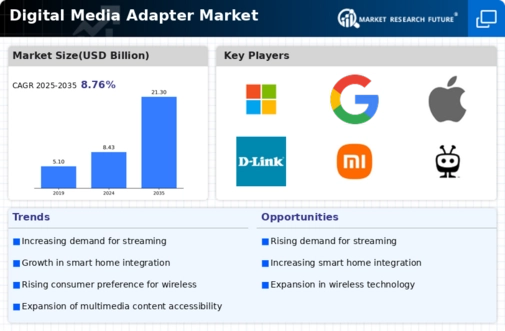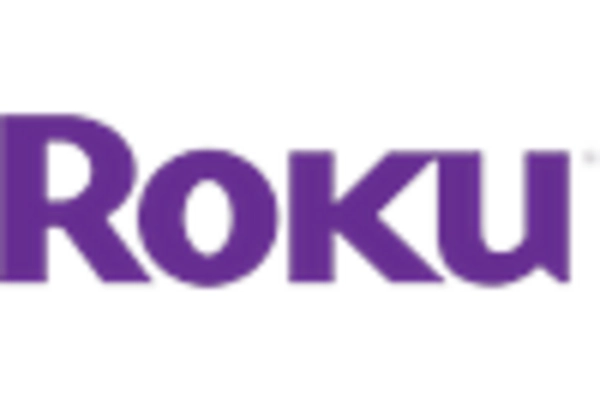Growth of Smart Home Devices
The proliferation of smart home devices is another significant driver for the Digital Media Adapter Market. As households increasingly adopt smart technologies, the need for devices that can integrate and control these systems becomes paramount. Digital media adapters often serve as a hub, allowing users to connect various smart devices and control them through a single interface. Market analysis indicates that the smart home market is projected to grow at a compound annual growth rate of over 25% in the coming years. This growth presents a substantial opportunity for digital media adapter manufacturers to develop products that cater to the evolving needs of tech-savvy consumers, thereby enhancing the Digital Media Adapter Market.
Rising Demand for Streaming Services
The increasing popularity of streaming services is a primary driver for the Digital Media Adapter Market. As consumers shift from traditional cable television to on-demand streaming platforms, the need for devices that facilitate this transition has surged. Reports indicate that the number of streaming subscribers has reached over 1 billion, highlighting a significant market opportunity. Digital media adapters serve as essential tools for connecting televisions to these services, enabling users to access a wide array of content seamlessly. This trend is likely to continue, as more consumers seek flexibility and convenience in their viewing habits, further propelling the growth of the Digital Media Adapter Market.
Increased Focus on Content Accessibility
The heightened focus on content accessibility is a crucial driver for the Digital Media Adapter Market. As more consumers seek to access diverse content from various sources, the demand for devices that facilitate this access is growing. Digital media adapters enable users to connect to a multitude of platforms, including social media, gaming, and educational content. Market trends suggest that the accessibility of content is becoming a key factor in consumer purchasing decisions, with many prioritizing devices that offer a wide range of options. This trend is likely to continue, as the desire for diverse and easily accessible content propels the growth of the Digital Media Adapter Market.
Technological Advancements in Connectivity
Technological innovations in connectivity options are significantly influencing the Digital Media Adapter Market. The advent of technologies such as HDMI, Wi-Fi 6, and Bluetooth 5.0 has enhanced the performance and user experience of digital media adapters. These advancements allow for faster data transfer rates and improved streaming quality, which are crucial for consumers who demand high-definition content. Market data suggests that the adoption of these technologies is expected to grow, with projections indicating that the market for HDMI-enabled devices alone could reach several billion dollars by 2026. As a result, manufacturers are increasingly focusing on integrating these technologies into their products, thereby driving the Digital Media Adapter Market forward.
Consumer Preference for Multi-Device Compatibility
Consumer preference for multi-device compatibility is shaping the Digital Media Adapter Market. As individuals own multiple devices, including smartphones, tablets, and laptops, the demand for adapters that can seamlessly connect these devices to televisions and other displays is increasing. This trend is evident in the rising sales of adapters that support various operating systems and platforms. Market data reveals that products offering cross-compatibility are gaining traction, with sales expected to rise significantly in the next few years. This shift indicates that manufacturers must prioritize versatility in their product designs to meet consumer expectations, thereby driving the Digital Media Adapter Market.
















Leave a Comment